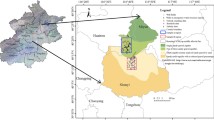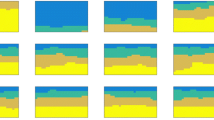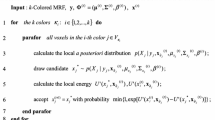Abstract
Multidimensional Markov chain models in geosciences were often built on multiple chains, one in each direction, and assumed these 1-D chains to be independent of each other. Thus, unwanted transitions (i.e., transitions of multiple chains to the same location with unequal states) inevitably occur and have to be excluded in estimating the states at unobserved locations. This consequently may result in unreliable estimates, such as underestimation of small classes (i.e., classes with smaller than average areas) in simulated realizations. This paper presents a single-chain-based multidimensional Markov chain model for estimation (i.e., prediction and conditional stochastic simulation) of spatial distribution of subsurface formations with borehole data. The model assumes that a single Markov chain moves in a lattice space, interacting with its nearest known neighbors through different transition probability rules in different cardinal directions. The conditional probability distribution of the Markov chain at the location to be estimated is formulated in an explicit form by following the Bayes’ Theorem and the conditional independence of sparse data in cardinal directions. Since no unwanted transitions are involved, the model can estimate all classes fairly. Transiogram models (i.e., 1-D continuous Markov transition probability diagrams) are used to provide transition probability input with needed lags to generalize the model. Therefore, conditional simulation can be conducted directly and efficiently. The model provides an alternative for heterogeneity characterization of subsurface formations.
Similar content being viewed by others
References
Abend K, Harley TJ and Kanal LN (1965). Classification of binary random patterns. IEEE Trans Inf Theory 11: 538–544
Besag J (1986). On the statistical analysis of dirty pictures (with discussions). J Roy Stat Soc Ser B 48: 259–302
Bierkens MFP and Weerts HJT (1994). Application of indicator simulation to modelling the lithological properties of a complex confining layer. Geoderma 62: 265–284
Carle SF and Fogg GE (1997). Modeling spatial variability with one- and multi-dimensional continuous Markov chains. Math Geol 29: 891–918
Derin H, Elliott H, Cristi R and Geman D (1984). Bayes smoothing algorithms for segmentation of binary images modeled by Markov random fields. IEEE Trans Pattern Anal Mach Intell 6: 707–720
Deutsch CV and Journel AG (1998). GSLIB: geostatistics software library and user’s guide, 2nd edn. Oxford University Press, New York
Elfeki AM and Dekking FM (2001). A Markov chain model for subsurface characterization: theory and applications. Math Geol 33: 569–589
Fjortoft R, Delignon Y, Pieczynski W, Sigelle M and Tupin F (2003). Unsupervised classification of radar images using hidden Markov chains and hidden Markov random fields. IEEE Trans Geosci Remote Sens 41: 675–686
Geman S and Geman D (1984). Stochastic relaxation, Gibbs distributions and the Bayesian restoration of images. IEEE Trans Pattern Anal Mach Intell PAMI-6: 721–741
Gray AJ, Kay IW and Titterington DM (1994). An empirical study of the simulation of various models used for images. IEEE Trans Pattern Anal Mach Intell 16: 507–513
Haslett J (1985). Maximum likelihood discriminant analysis on the plane using a Markovian model of spatial context. Pattern Recognit 18: 287–296
Idier J, Goussard Y and Ridolfi A (2001). Unsupervised image segmentation using a telegraph parameterization of Pickard random fields. In: Moore, M (eds) Spatial statistics: methodological aspects and some applications, Lecture Notes in Statistics, vol 159, pp 115–140. Springer Verlag, New York
Koltermann EC and Gorelick SM (1996). Heterogeneity in sedimentary deposits: a review of structure-imitating, process-imitating and descriptive approaches. Water Resour Res 32: 2617–2658
Krumbein WC (1968) FORTRAN IV computer program for simulation of transgression and regression with continuous time Markov models, Computer Contribution 26, Kansas Geology Survey
Li W (2006). Transiogram: a spatial relationship measure for categorical data. Int J Geogr Inf Sci 20: 693–699
Li W (2007). Markov chain random fields for estimation of categorical variables. Math Geol 39: 321–335
Li W, Li B, Shi Y and Tang D (1997). Application of the Markov-chain theory to describe spatial distribution of textural layers. Soil Sci 162: 672–683
Li W and Zhang C (2005). Application of transiograms to Markov chain simulation and spatial uncertainty assessment of land-cover classes. GISci Remote Sens 42: 297–319
Li W and Zhang C (2006). A generalized Markov chain approach for conditional simulation of categorical variables from grid samples. Trans GIS 10: 651–669
Li W, Zhang C, Burt JE, Zhu AX and Feyen J (2004). Two-dimensional Markov chain simulation of soil type spatial distribution. Soil Sci Soc Am J 68: 1479–1490
Lin C and Harbaugh JW (1984). Graphic display of two- and three-dimensional Markov computer models in geology. Van Nostrand Reinhold Company, New York
Lou J (1996). Transition probability approach to statistical analysis of spatial qualitative variables in geology. In: Forster, A and Merriam, DF (eds) Geologic modeling and mapping, pp 281–299. Plenum Press, New York
Norberg T, Rosen L, Baran A and Baran S (2002). On modeling discrete geological structure as Markov random fields. Math Geol 34: 63–77
Patil GP and Taillie C (2001). A multiscale hierarchical Markov transition matrix model for generating and analyzing thematic raster maps. Environ Ecol Stat 8: 71–84
Pickard DK (1980). Unilateral Markov fields. Adv Appl Probab 12: 655–671
Qian W and Titterington DM (1991). Multidimensional Markov chain models for image textures. J Roy Stat Soc Ser B 53: 661–674
Rosholm A (1997) Statistical methods for segmentation and classification of images, PhD Dissertation, Technical University of Denmark, Lyngby
Sharp WE and Aroian LA (1985). The generation of multidimensional autoregressive series by the herringbone method. Math Geol 17: 67–79
Tjelmeland H and Besag J (1998). Markov random fields with higher-order interactions. Scand J Stat 25: 415–433
Weigand H, Totsche KU, Huwe B and Kogel-Knabner I (2001). PAH mobility in contaminated industrial soils: a Markov chain approach to the spatial variability of soil properties and PAH levels. Geoderma 102: 371–389
Wu K, Nunan N, Crawford JW, Young IM and Ritz K (2004). An efficient Markov chain model for the simulation of heterogeous soil structure. Soil Sci Soc Am J 68: 346–351
Author information
Authors and Affiliations
Corresponding author
Rights and permissions
About this article
Cite this article
Li, W., Zhang, C. A single-chain-based multidimensional Markov chain model for subsurface characterization. Environ Ecol Stat 15, 157–174 (2008). https://doi.org/10.1007/s10651-007-0045-9
Received:
Revised:
Published:
Issue Date:
DOI: https://doi.org/10.1007/s10651-007-0045-9




